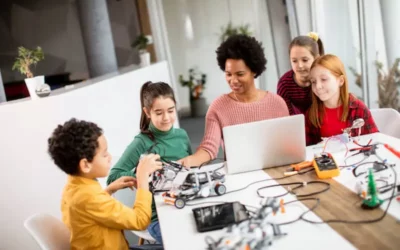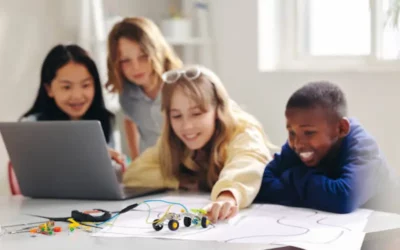Welcome, curious parents, to a world where imagination meets innovation, and playtime transforms into a thrilling journey of discovery! Today, we invite you to dive into the captivating universe of robotics classes for kids, where learning becomes an exhilarating adventure that sparks curiosity and ignites young minds.
In this age of rapid technological advancement, it’s never been more important to equip our children with the skills they need to thrive in the future. Robotics programs offer a unique blend of education and entertainment, empowering young learners to embrace the exciting realm of science, technology, engineering, and mathematics (STEM).
Through engaging and hands-on activities, robotics classes immerse children in a world where they become inventors, programmers, and engineers, all while having an absolute blast. They explore fascinating concepts like artificial intelligence, sensors, and automation in a way that sparks their imagination and enthusiasm.
So, dear parents, if you’re searching for an educational adventure that combines entertainment, skill-building, and a healthy dose of fun, look no further. Join us as we embark on a captivating journey into the world of robotics classes for kids, where knowledge blossoms, friendships flourish, and dreams of innovation take flight. Together, let’s nurture the next generation of brilliant minds and empower them to shape the future with creativity and ingenuity!
Table of contents
- What are Robotics Classes?
- Why Choose Robotics Classes for Kids?
- Benefits of Robotics Classes
- Age-Appropriate Robotics Programs: Inspiring Young Minds at Every Stage
- Curriculum and Learning Objectives
- Hands-On Learning and Creativity
- Building Problem-Solving Skills
- Collaboration and Teamwork
- Introduction to Coding
- Robotics and STEM Education
- Robotics Competitions and Challenges
- Choosing the Right Robotics Class
- Finding Local Robotics Programs
- Parental Involvement and Support
- Fun Activities and Projects in Robotics Classes
- Conclusion
- Frequently Asked Questions
What are Robotics Classes?
Robotics classes are educational programs that introduce children to the fascinating field of robotics. In these classes, kids have the opportunity to work with various robotic kits for kids, tools, and software to design, build, and program their own robots. Through hands-on activities, they learn how to assemble mechanical components, connect circuits, and write simple code to bring their creations to life.
Why Choose Robotics Classes for Kids?
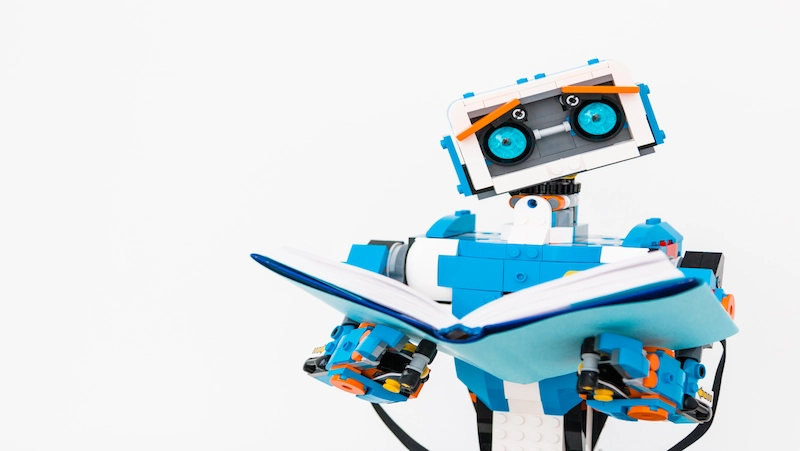
In today’s ever-evolving world, equipping our kids with the skills they need to thrive in the future has become a top priority. As technology continues to shape our lives, there’s no denying the growing importance of STEM education. And when it comes to fostering a passion for science, technology, engineering, and mathematics, robotics classes for kids are leading the way.
1. Hands-On Learning
Robotics classes offer a hands-on learning experience that goes beyond traditional classroom settings. Children actively engage in the process of building and programming robots, allowing them to apply theoretical knowledge to practical applications.
2. Stimulates Creativity
Robotics classes foster creativity by encouraging children to think outside the box. They learn to brainstorm ideas, design unique robots, and solve problems creatively. This process nurtures their imagination and innovation skills.
3. Enhances Problem-Solving Skills
Robotics classes teach kids to approach challenges with a problem-solving mindset. They learn to identify problems, break them down into smaller tasks, and develop strategies to overcome obstacles. These problem-solving skills are transferable to various areas of their lives.
4. Promotes Collaboration and Teamwork
Working on robotics projects often involves teamwork, allowing children to develop essential collaboration skills. They learn to communicate, share ideas, and work together towards a common goal. This collaborative environment builds their social skills and teaches them the value of cooperation.
5. Introduction to Coding
Robotics classes provide a stepping stone to coding for kids. Children learn the basics of programming by writing simple code to control their robots’ movements and actions. This introduction to coding lays a solid foundation for future technological literacy.
Benefits of Robotics Classes
Participating in robotics classes can have numerous benefits for children. Here are some advantages they can gain from engaging in these educational programs:
- Develops critical thinking skills for kids through problem-solving activities.
- Enhances creativity and imagination by designing and building unique robots.
- Builds technological literacy and prepares kids for the digital future.
- Cultivates persistence and resilience when facing challenges.
- Fosters a love for STEM subjects and encourages further exploration.
- Improves communication and teamwork abilities through collaborative projects.
- Boosts confidence and self-esteem as children see their ideas come to life.
- Provides exposure to real-world applications of science and technology.
Age-Appropriate Robotics Programs: Inspiring Young Minds at Every Stage

When it comes to introducing our children to the captivating world of robotics, one size does not fit all. Each age group has unique characteristics, interests, and learning abilities, making it essential to find age-appropriate robotics programs that cater to their specific needs. Let’s take a closer look at how these programs are tailored to different age groups, ensuring a truly enriching experience for our budding innovators.
Robotics Programs for 5-Year-Olds: The Spark of Wonder
At the tender age of five, our little ones are brimming with curiosity and an innate desire to explore. Robotics programs for this age group focus on sparking their wonder and introducing them to basic concepts in a playful and interactive manner.
Through colorful building blocks, simple coding games for kids, and friendly robot characters, children learn the foundations of robotics while developing fine motor skills and hand-eye coordination. These programs encourage imaginative play, fostering a love for STEM from the earliest stages of their educational journey.
Robotics Programs for 10-Year-Olds: Building a Foundation
As children reach the age of 10, their cognitive abilities expand, allowing them to grasp more complex ideas. Robotics programs for this age group provide a hands-on approach, where budding engineers delve into assembling robots from scratch.
They learn about circuitry, sensors, and programming concepts that enable their creations to perform specific tasks. These programs promote problem-solving skills, logical thinking, and the importance of persistence as young learners tackle challenges and discover the joy of bringing their ideas to life.
Robotics Programs for Teens: Innovators of Tomorrow
Teenagers are at a stage where they are ready to push boundaries, explore advanced concepts, and apply their knowledge to real-world scenarios. Robotics programs designed for teens offer a deeper dive into robotics, covering topics such as artificial intelligence, machine learning, and autonomous systems.
These programs encourage innovation and critical thinking, challenging teens to create robots that tackle complex problems and engage in exciting competitions. Through teamwork and collaboration, they develop essential skills like communication, leadership, and project management, preparing them for the challenges of the future.
All-Age Robotics Programs: Uniting Young Minds
In addition to age-specific programs, there are also all-age robotics programs that bring children from different age groups together. These programs foster a sense of camaraderie, allowing younger children to learn from older peers and vice versa.
The diverse mix of talents and perspectives creates an inspiring learning environment where collaboration and mentorship thrive. It’s a wonderful opportunity for children to build friendships, gain exposure to various skill levels, and experience the joy of collective achievement.
By tailoring the curriculum, activities, and challenges to their specific age group, these programs ensure that our young innovators receive the right blend of education and entertainment. So, let’s celebrate the diversity of our children’s learning journeys and empower them to reach new heights in the fascinating world of robotics.

Curriculum and Learning Objectives
Robotics classes typically follow a well-structured curriculum that aligns with the learning objectives for each age group. The curriculum may include the following key areas:
Introduction to Robotics: Children learn about the history and fundamentals of robotics, exploring different types of robots and their applications.
Robotics Components: Kids get hands-on experience with various robotic kits and tools, learning about sensors, motors, actuators, and other components.
Basic Electronics: They gain an understanding of basic electronics principles and circuits, allowing them to connect components and troubleshoot issues.
Programming Fundamentals: Children learn the basics of programming, using block-based coding platforms or simple programming languages to control their robots.
Robot Construction: They develop skills in assembling and constructing robots, understanding the importance of structural integrity and efficient design.
Problem-Solving Challenges: Kids are presented with various challenges that require them to think critically, experiment, and come up with innovative solutions.
Hands-On Learning and Creativity
One of the highlights of robotics classes for kids is the emphasis on hands-on learning. By engaging in practical activities, children develop a deeper understanding of scientific concepts and engineering principles. They gain firsthand experience in designing and building robots, which sparks their creativity and problem-solving skills.
Whether it’s constructing a robotic arm, designing a line-following robot, or programming a robot to navigate a maze, each project offers a unique opportunity for kids to explore their imagination and unleash their innovative ideas.
Building Problem-Solving Skills
Robotics classes are an excellent avenue for children to sharpen their problem-solving skills. As they encounter challenges during the robot-building process, they learn to approach problems analytically and break them down into manageable steps.
They develop the ability to think critically, analyze information, and devise effective solutions. These problem-solving skills extend beyond robotics and become valuable assets that children can apply to various academic and real-life situations.
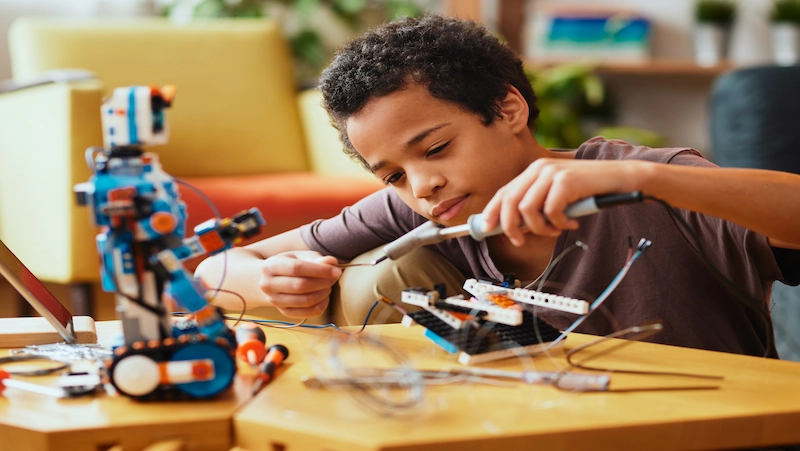
Collaboration and Teamwork
In robotics classes, collaboration and teamwork play a crucial role. Children often work in pairs or groups to complete projects and overcome challenges together. They learn the importance of effective communication, active listening, and respecting others’ ideas.
By working collaboratively, kids discover the power of synergy and how combining their strengths and skills can lead to remarkable achievements. These collaborative experiences lay a strong foundation for their future interactions in school, work, and social settings.
Introduction to Coding
Coding is an essential skill in today’s technology-driven world, and robotics classes provide an ideal introduction to this field. Children learn the basics of programming as they write code to control their robots’ actions and behaviors. They gain an understanding of sequencing, loops, conditions, and logical thinking.
By experimenting with different code blocks and commands, kids witness the immediate results of their programming decisions. This interactive and hands-on approach to coding makes it engaging and enjoyable for young learners.
Robotics and STEM Education
Robotics classes for kids are deeply rooted in STEM education. STEM stands for science, technology, engineering, and mathematics – key disciplines that form the foundation of robotics. Through robotics programs, children actively engage with these subjects in a practical and meaningful way.
They learn scientific concepts, apply mathematical principles, employ engineering principles in building robots, and utilize technology for programming and automation. The integration of STEM education and robotics sparks curiosity and inspires children to pursue further exploration in these fields.
Robotics Competitions and Challenges
Robotics classes often provide opportunities for children to participate in competitions and challenges. These events allow kids to apply their knowledge and skills in a competitive yet fun environment.
Competitions can range from simple tasks such as robot races or maze navigation to more complex challenges that involve problem-solving, strategy, and teamwork. Participating in competitions enhances children’s motivation, fosters healthy competition, and encourages them to push their boundaries to achieve their goals.
Choosing the Right Robotics Class
When selecting a robotics class for your child, consider the following factors:
- Age Appropriateness: Ensure that the class is designed for your child’s age group to provide an optimal learning experience.
- Curriculum and Learning Objectives: Look for classes that offer a well-structured curriculum aligned with the skills and knowledge you want your child to gain.
- Qualified Instructors: Check if the instructors have experience in teaching robotics and possess the necessary expertise to guide children effectively.
- Hands-On Activities: Confirm that the class emphasizes hands-on activities, as practical learning is crucial for children’s engagement and understanding.
- Student-to-Instructor Ratio: A smaller student-to-instructor ratio ensures that each child receives adequate attention and support during the learning process.
- Safety Measures: Inquire about the safety protocols in place to protect children during hands-on activities involving tools, equipment, and electrical components.
Finding Local Robotics Programs
To find local robotics programs for your child, consider the following resources:
- Schools: Check if your child’s school offers robotics classes or has partnerships with organizations that provide robotics programs.
- Community Centers: Look for community centers, libraries, or science centers that offer robotics classes or workshops.
- STEM Organizations: Research local STEM organizations or clubs that specialize in robotics education.
- Online Directories: Utilize online directories or search engines to find robotics programs in your area.
- Word of Mouth: Seek recommendations from other parents, teachers, or friends who have enrolled their children in robotics classes.
Parental Involvement and Support
As a parent, your involvement and support are crucial in maximizing the benefits of robotics classes for your child. Here’s how you can contribute:
- Encourage and Motivate: Show interest in your child’s robotics projects and encourage them to explore new ideas and overcome challenges.
- Ask Open-Ended Questions: Engage your child in conversations about their robotics experiences. Ask open-ended questions to stimulate critical thinking and reflection.
- Create a Home Learning Environment: Provide resources like robotics kits, books, or online tutorials for your child to further explore robotics concepts at home.
- Attend Competitions and Exhibitions: Show support by attending robotics competitions or exhibitions where your child can showcase their achievements and learn from others.
- Celebrate Achievements: Acknowledge your child’s accomplishments and celebrate their progress in robotics. This positive reinforcement boosts their confidence and motivates them to continue their learning journey.
By considering these factors and keeping your child’s interests and learning style in mind, you’ll be well on your way to choosing the right robotics class. Remember, it’s not just about imparting technical knowledge but also fostering a love for exploration, critical thinking, and problem-solving.
Robochamps is one such robotics program that offers such features for your kids learning. With a team of highly skilled and dedicated instructors, RoboChamps ensures that your kids receive top-notch guidance and support throughout their robotics journey.
The program’s emphasis on hands-on learning allows children to actively engage with various robotics projects and develop critical problem-solving and analytical skills. Whether it’s building and programming robots or participating in exciting challenges, RoboChamps offers a dynamic and stimulating environment for kids to explore the world of robotics.
Fun Activities and Projects in Robotics Classes
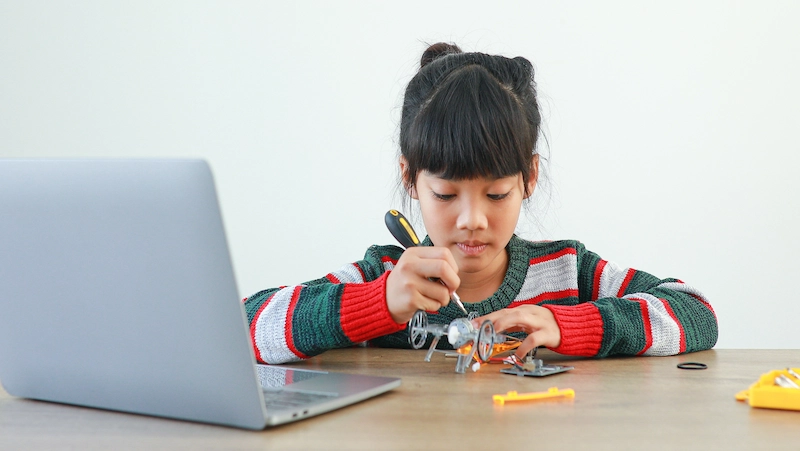
Engaging young minds in robotics classes goes beyond just lectures and theory. These classes are a vibrant playground where children delve into hands-on activities and thrilling projects that ignite their passion for technology. Get ready to discover some incredibly fun activities and projects that will have your child buzzing with excitement during their robotics journey!
- Build Your Own Robot Friend:
One of the most exciting aspects of robotics classes is the opportunity for children to construct their own robotic companions. From assembling the mechanical components to wiring the circuits and programming their functionalities, this project allows their creativity to soar. They can design robots with expressive faces, playful movements, or even robots that respond to voice commands. The joy and sense of accomplishment that come from breathing life into their own creation is truly priceless. - Robot Races:
Who doesn’t love a little friendly competition? Robot races are a thrilling way for children to apply their knowledge of programming and robotics. They can build speedy line-following robots and program them to navigate a track, maneuvering through twists, turns, and obstacles. Watching their robots whiz past the finish line, children experience the thrill of victory and learn valuable lessons about precision, agility, and problem-solving. - Robotic Art and Design:
Combining technology with creativity, this activity opens a world of possibilities. Children can explore robotic art by designing robots that paint, sketch, or create stunning patterns. They can also incorporate their robots into interactive installations, where movements and sensors trigger visual or auditory effects. This fusion of technology and art encourages children to think beyond traditional boundaries, unleashing their artistic expression while honing their technical skills. - Rescue Missions:
Prepare your child for an adventure like no other! In rescue mission projects, children design robots capable of navigating challenging terrains and saving the day. Whether it’s a simulated earthquake zone or a treacherous maze, their robots become heroes as they locate and rescue objects or navigate obstacles to reach the target. This activity fosters critical thinking, problem-solving, and strategic planning while keeping children engaged and motivated. - Sumo Robot Battles:
Get ready to rumble in the world of sumo robot battles! This activity brings together the thrill of robotics and the excitement of competition. Children design and program robots that face off in a sumo-style ring, attempting to push each other out of bounds. The objective? Be the last robot standing! Sumo battles teach children about design optimization, weight distribution, and programming strategies, all while providing endless entertainment and friendly rivalry. - Robot Show-and-Tell:
Encourage your child’s communication and presentation skills by organizing a robot show-and-tell session. Children can showcase their robot creations, explaining their functionalities and the process behind their construction. This activity not only boosts confidence but also fosters a sense of pride in their achievements. It also provides an opportunity for other children to be inspired and learn from their peers’ projects, creating a vibrant atmosphere of knowledge sharing.
Engaging activities and projects like these make robotics classes an unforgettable experience for children. By combining education, innovation, and pure enjoyment, these hands-on adventures empower young minds to explore, experiment, and grow!
Conclusion
Robotics classes for kids offer a captivating and educational journey into the world of technology, creativity, and problem-solving. By enrolling your child in these engaging programs, you provide them with the opportunity to develop essential skills, such as critical thinking, collaboration, and coding, in a fun and interactive way.
Embrace the exciting world of robotics courses for kids and witness your child’s imagination soar as they build, program, and explore the endless possibilities of robotics. Enroll your child today and watch them embark on a remarkable adventure of discovery and learning!
RoboChamps, brought to you by BrightChamps, is a thrilling and innovative program that pushes the boundaries of technological education. With RoboChamps, children delve into the captivating world of robotics, learning and honing their skills in a hands-on, interactive environment.
BrightChamps takes pride in offering a unique experience that fosters creativity, critical thinking, and problem-solving abilities. Through RoboChamps, young minds are empowered to unleash their potential, embrace challenges, and become the champions of tomorrow’s technological landscape. Join RoboChamps and embark on an exhilarating journey of discovery and growth!
Frequently Asked Questions
A1. Robotics classes cater to various age groups, starting from preschool to high school and beyond. There are age-appropriate programs available to ensure that children can engage with robotics concepts and activities suitable for their developmental stage.
A2. Robotics classes promote critical thinking skills by presenting children with challenges and problems to solve. They learn to analyze situations, think logically, break down problems into smaller parts, and devise innovative solutions using their knowledge of robotics and STEM.
Consider buying a beginner-friendly robotics kit for kids or signing up for a robotics workshop to get kids started learning robotics. Interactive tutorials are also offered through books, educational websites, and online sources. To build curiosity and problem-solving abilities, encourage practical experimentation and discovery.
Absolutely! Robotics classes are open to both boys and girls. It’s essential to encourage and provide opportunities for girls to participate in STEM-related activities, including robotics. These classes promote inclusivity and diversity, fostering an environment where all children can thrive.
The cost of robotics classes varies depending on factors such as the program’s duration, curriculum, materials provided, and the expertise of the instructors. Some programs offer scholarships or financial assistance, so it’s worth exploring different options to find one that suits your budget.
A6. Use age-appropriate kits or toys to introduce robotics to your 7-year-old. Start with fundamental ideas like creating and programming easy robots. To improve their learning experience, encourage hands-on experimentation, offer assistance, and provide resources like books or online courses.
A7Robotics is not a maths course, no. While programming and computing coordinates are two common tasks in robotics that include arithmetic, the study of robotics itself includes many other disciplines, including engineering, computer science, and mechanics.
A8. Through practical robot activities, primary school robotics classes aim to introduce children to the fundamentals of programming and engineering. It stimulates interest in STEM disciplines while assisting in the development of problem-solving, critical thinking, and collaborative skills.
A9. Students study the fundamentals and uses of robotics in a robotics class, covering subjects such robot design, programming, sensors and actuators, artificial intelligence, and problem-solving. They receive practical expertise in designing and creating robots that can carry out particular duties.
A10. In addition to FIRST LEGO League Jr. (for children in grades K–4), FIRST LEGO League (for students in grades 4–8), FIRST Tech Challenge, and FIRST Robotics Competition (for students in grades 7–12), First Robotics offers programs for students in grades K–12.

 We are an army of educators and passionate learners from BrightChamps family, committed to providing free learning resources to kids, parents & students.
We are an army of educators and passionate learners from BrightChamps family, committed to providing free learning resources to kids, parents & students.










